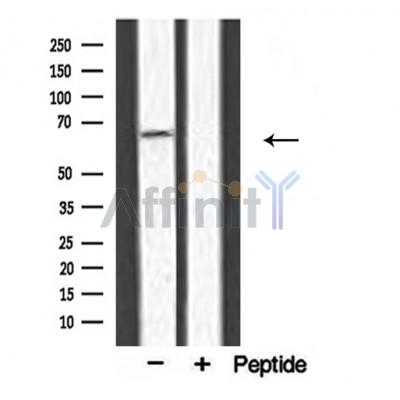APPBP2 Antibody - #DF3771
| Product: | APPBP2 Antibody |
| Catalog: | DF3771 |
| Description: | Rabbit polyclonal antibody to APPBP2 |
| Application: | WB IHC IF/ICC |
| Reactivity: | Human, Mouse, Rat |
| Prediction: | Pig, Zebrafish, Bovine, Horse, Sheep, Rabbit, Dog, Chicken, Xenopus |
| Mol.Wt.: | 67 KD; 67kD(Calculated). |
| Uniprot: | Q92624 |
| RRID: | AB_2836135 |
Related Downloads
Protocols
Product Info
*The optimal dilutions should be determined by the end user. For optimal experimental results, antibody reuse is not recommended.
*Tips:
WB: For western blot detection of denatured protein samples. IHC: For immunohistochemical detection of paraffin sections (IHC-p) or frozen sections (IHC-f) of tissue samples. IF/ICC: For immunofluorescence detection of cell samples. ELISA(peptide): For ELISA detection of antigenic peptide.
Cite Format: Affinity Biosciences Cat# DF3771, RRID:AB_2836135.
Fold/Unfold
amyloid beta precursor protein (cytoplasmic tail) binding protein 2; Amyloid beta precursor protein-binding protein 2; Amyloid protein binding protein 2; Amyloid protein-binding protein 2; APBP2_HUMAN; APP BP2; APP-BP2; Appbp2; PAT1; Protein interacting with APP tail 1;
Immunogens
A synthesized peptide derived from human APPBP2, corresponding to a region within the internal amino acids.
- Q92624 APBP2_HUMAN:
- Protein BLAST With
- NCBI/
- ExPASy/
- Uniprot
MAAVELEWIPETLYNTAISAVVDNYIRSRRDIRSLPENIQFDVYYKLYQQGRLCQLGSEFCELEVFAKVLRALDKRHLLHHCFQALMDHGVKVASVLAYSFSRRCSYIAESDAAVKEKAIQVGFVLGGFLSDAGWYSDAEKVFLSCLQLCTLHDEMLHWFRAVECCVRLLHVRNGNCKYHLGEETFKLAQTYMDKLSKHGQQANKAALYGELCALLFAKSHYDEAYKWCIEAMKEITAGLPVKVVVDVLRQASKACVVKREFKKAEQLIKHAVYLARDHFGSKHPKYSDTLLDYGFYLLNVDNICQSVAIYQAALDIRQSVFGGKNIHVATAHEDLAYSSYVHQYSSGKFDNALFHAERAIGIITHILPEDHLLLASSKRVKALILEEIAIDCHNKETEQRLLQEAHDLHLSSLQLAKKAFGEFNVQTAKHYGNLGRLYQSMRKFKEAEEMHIKAIQIKEQLLGQEDYEVALSVGHLASLYNYDMNQYENAEKLYLRSIAIGKKLFGEGYSGLEYDYRGLIKLYNSIGNYEKVFEYHNVLSNWNRLRDRQYSVTDALEDVSTSPQSTEEVVQSFLISQNVEGPSC
Predictions
Score>80(red) has high confidence and is suggested to be used for WB detection. *The prediction model is mainly based on the alignment of immunogen sequences, the results are for reference only, not as the basis of quality assurance.
High(score>80) Medium(80>score>50) Low(score<50) No confidence
Research Backgrounds
May play a role in intracellular protein transport. May be involved in the translocation of APP along microtubules toward the cell surface.
Rapidly degraded by the proteasome upon overexpression of a C-terminal fragment of APP.
Nucleus. Cytoplasm>Cytoskeleton. Membrane>Peripheral membrane protein.
Note: Associated with membranes and microtubules.
Restrictive clause
Affinity Biosciences tests all products strictly. Citations are provided as a resource for additional applications that have not been validated by Affinity Biosciences. Please choose the appropriate format for each application and consult Materials and Methods sections for additional details about the use of any product in these publications.
For Research Use Only.
Not for use in diagnostic or therapeutic procedures. Not for resale. Not for distribution without written consent. Affinity Biosciences will not be held responsible for patent infringement or other violations that may occur with the use of our products. Affinity Biosciences, Affinity Biosciences Logo and all other trademarks are the property of Affinity Biosciences LTD.



